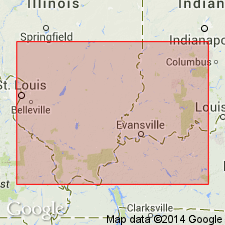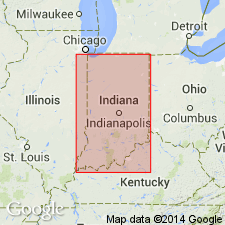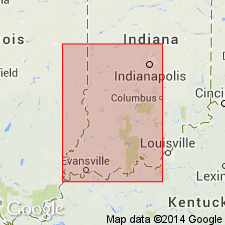
- Usage in publication:
-
- Popcorn Sandstone Bed
- Modifications:
-
- Named
- Dominant lithology:
-
- Sandstone
- Shale
- Limestone
- AAPG geologic province:
-
- Illinois basin
Summary:
Name Popcorn Sandstone Bed proposed for bed of sandstone, shale, or impure limestone of earliest Gasperian age that forms basal few inches or feet of Shetlerville Member of Renault Formation in IL or of Paoli Formation in Indiana and Kentucky. Underlies purer limestone beds forming rest of these units and overlies Levias Limestone Member of Renault Formation or beds assigned to the Ste. Genevieve that are equivalent to the Levias. Thickness 7 ft at type section in Lawrence Co., IN.
Source: GNU records (USGS DDS-6; Reston GNULEX).

- Usage in publication:
-
- Popcorn Member
- Modifications:
-
- Revised
- Overview
- AAPG geologic province:
-
- Illinois basin
Summary:
Popcorn Sandstone Bed of Swann (1963) here adopted as Popcorn Member of Paoli Limestone for usage by the Indiana Geological Survey as it provides an appropriate and useful name for the unit that marks the base of the Chesterian Series in Indiana. Along outcrop in Indiana, unit ranges from a few inches to 13 ft, but generally averages 1 to 3 ft. Lithology ranges from calcareous sandstone to calcareous green shale. Argillaceous and arenaceous limestones are probably the dominant lithologies. Underlies the Shetlerville Member of the Paoli Limestone and overlies the Ste. Genevieve Limestone. Widespread in outcrop from Crawford and Harrison Cos. on the Ohio River northward to Putnam Co.
Source: GNU records (USGS DDS-6; Reston GNULEX).

- Usage in publication:
-
- Popcorn Member†
- Modifications:
-
- Abandoned
- AAPG geologic province:
-
- Illinois basin
Summary:
Blue River Group of IN revised in this report. Supersedes State nomenclature established by Shaver and others (1986). Both in the subsurface and in outcrop, Blue River divided into (ascending) St. Louis, Ste. Genevieve, and Paoli Limestones. Aux Vases and Renault, previously regarded as formations in the subsurface, now treated as members of Paoli Limestone, both in the subsurface and in outcrop, replacing Popcorn and Shetlerville Members, which are here abandoned in Indiana. [IN is type locality state for Popcorn.]
Source: GNU records (USGS DDS-6; Reston GNULEX).
For more information, please contact Nancy Stamm, Geologic Names Committee Secretary.
Asterisk (*) indicates published by U.S. Geological Survey authors.
"No current usage" (†) implies that a name has been abandoned or has fallen into disuse. Former usage and, if known, replacement name given in parentheses ( ).
Slash (/) indicates name conflicts with nomenclatural guidelines (CSN, 1933; ACSN, 1961, 1970; NACSN, 1983, 2005, 2021). May be explained within brackets ([ ]).

